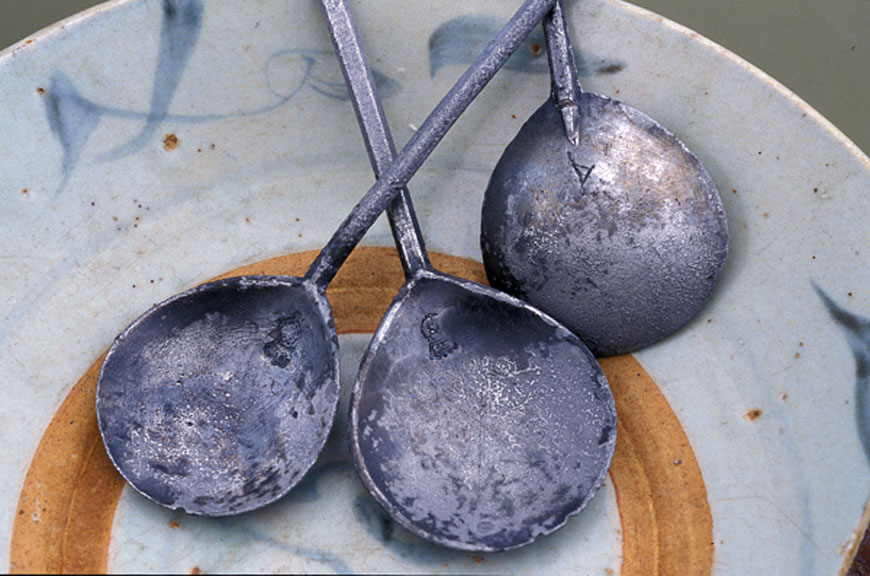Metals come from ores that form naturally in the environment. These ores are smelted and transformed from a stable mineral state to a less stable metallic state.
Most metal objects are made using alloys, a mixture of more than one metal. Combining metals provides certain qualities, strengths and colours. Gold, silver, copper alloy, pewter, tin and iron are found commonly in cultural objects.

Pewter spoons conserved by chemical reduction. Recovered from the VOC Avondster 1659 wreck site located in Galle Harbour, Sri Lanka. Photo: courtesy of Jon Carpenter, Maritime Archaeological Conservator, Western Australian Museum.
Causes of deterioration
Corrosion
Corrosion is the most common form of deterioration affecting metal objects. Corrosion occurs as a result of the unstable metal reacting with its environment causing it to revert to a more stable form.
Corrosion can occur through contact with water, acids, bases, salts, oils (including those secreted by human hands), aggressive metal polishes, gaseous materials (degrading plastics), pollutants (dirt, soot and dust) and various chemicals.
Noble metals – gold and silver – are more resistant to corrosion while base metals, like iron, tin and lead, are highly sensitive to corrosion mechanisms and can become very unstable. Different types of corrosion appear as thin, distinct layers or patina, or large, hard or powdery accretions. Once corrosion has begun the metal object becomes brittle and vulnerable to mechanical damage.
Mechanical Damage
Metals are considered to be strong and resilient though exhibit weakness and brittleness under certain conditions. Breakages, dents, and scratches from use, accidents, mishandling are common causes of deterioration of metal objects.
Over-polishing of metals gradually grinds away surface layers while chemical cleaning breaks down plating, surface decoration, maker’s marks and engravings activating and accelerating corrosion.
Treatments
Conservators treat corroded metals using mechanical, chemical and electrical interventions.
Investigative cleaning and X-radiography are useful to identify the metal’s condition, its level of deterioration and provides information about surface details, manufacture techniques, and casting flaws.
Specific solutions can remove corrosion after which inhibiters can be applied to protect the surface layers of exposed metal. The process of desalination can be used to remove corrosive salts followed by the application of waxes and acrylic resins as protective coatings to improve object stability.
Conservators use electrolytic cleaning or reduction to reverse the flow of electrons in the galvanic cell, which effectively converts corroded areas to a more stable or easy removed form of accretion. This technique is commonly used on iron excavated from marine environments, although it is unsuitable for highly corroded metals or as a general surface corrosion cleaning method.
Conservators can stabilise mechanical damage (if no corrosion has occurred) through re-joining breaks; applying surface protectors; by advising on appropriate handling and cleaning; and on the correct storage and display conditions to prevent further deterioration of the piece.
AICCM has a Special Interest Group for those interested in the conservation of objects, which includes metal objects. Join this group, contribute to its activities, or speak to a specialist conservator.
Need a conservator? Find one here
Resources
- A framework for conservation of metals (National Physical Laboratory) [PDF – 356 kb]
- Caring for your mementos – Medals (Australian War Memorial)
- Care and conservation of silver and plate (ICON) [PDF – 60kb]
- Caring for collections: How to care for metals (State Library of Queensland)
- Ancient & Historic Metals: Conservation and Scientific Research Edited by David A. Scott, Jerry Podany, and Brian B. Considine. Published by the Getty Conservation Institute 1994.